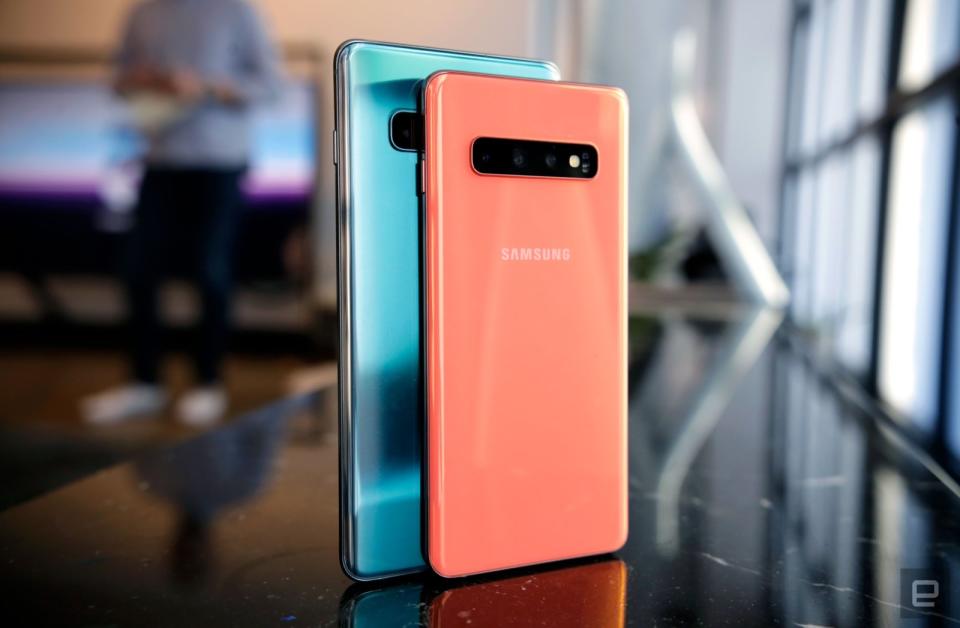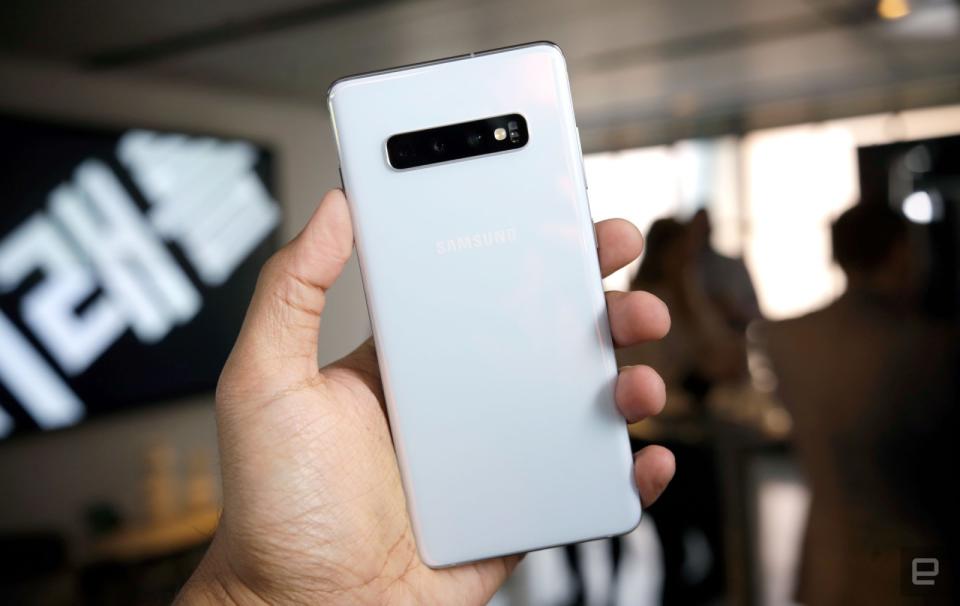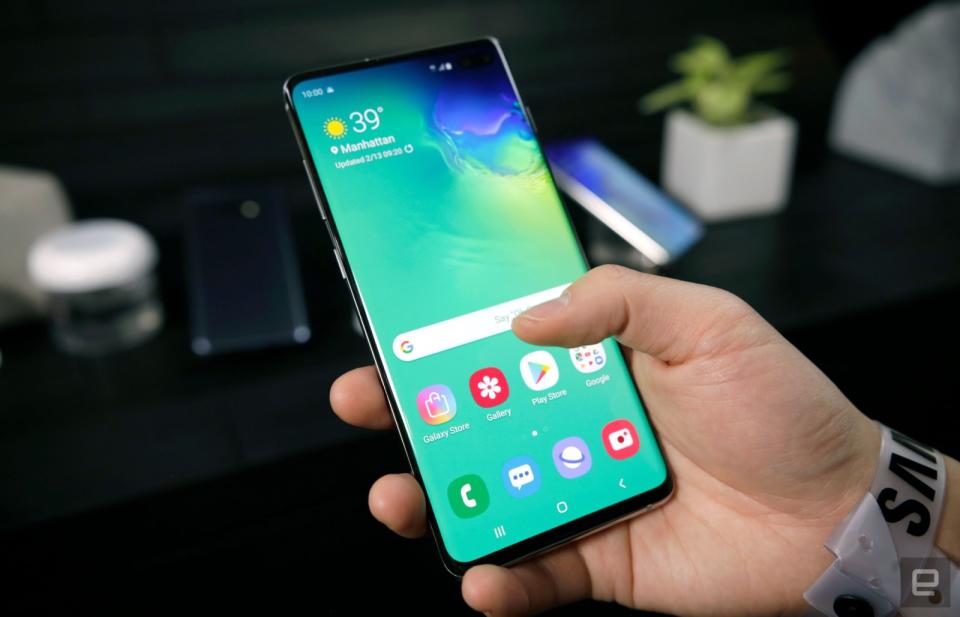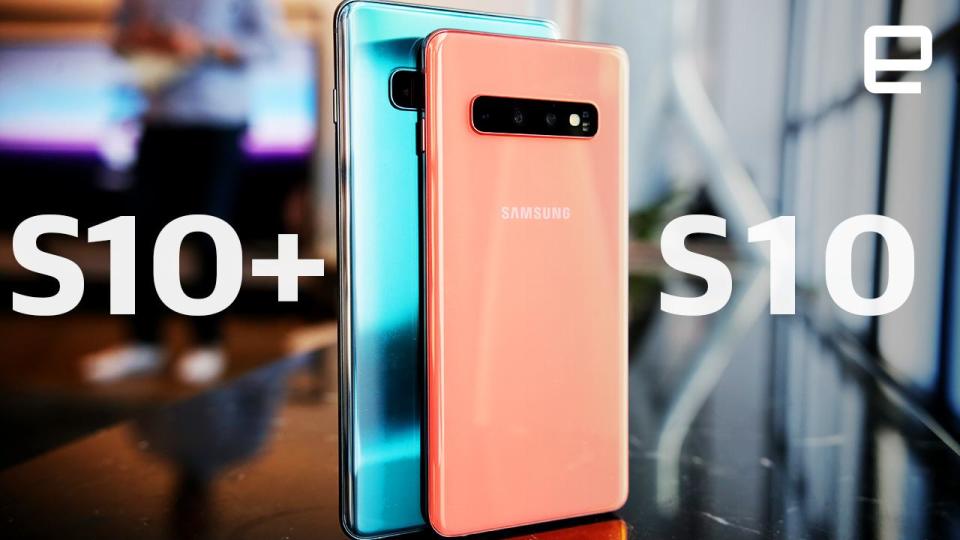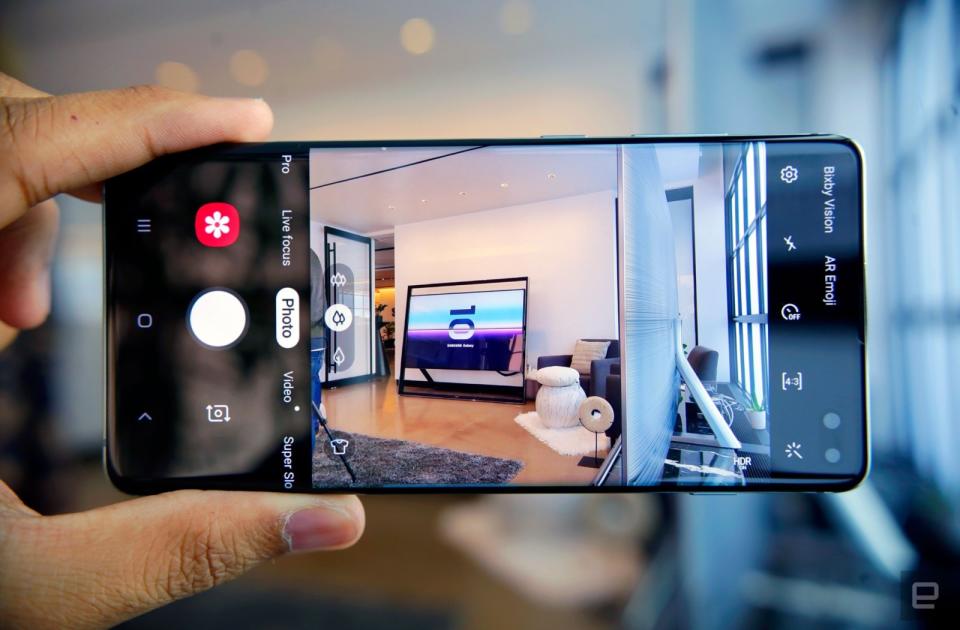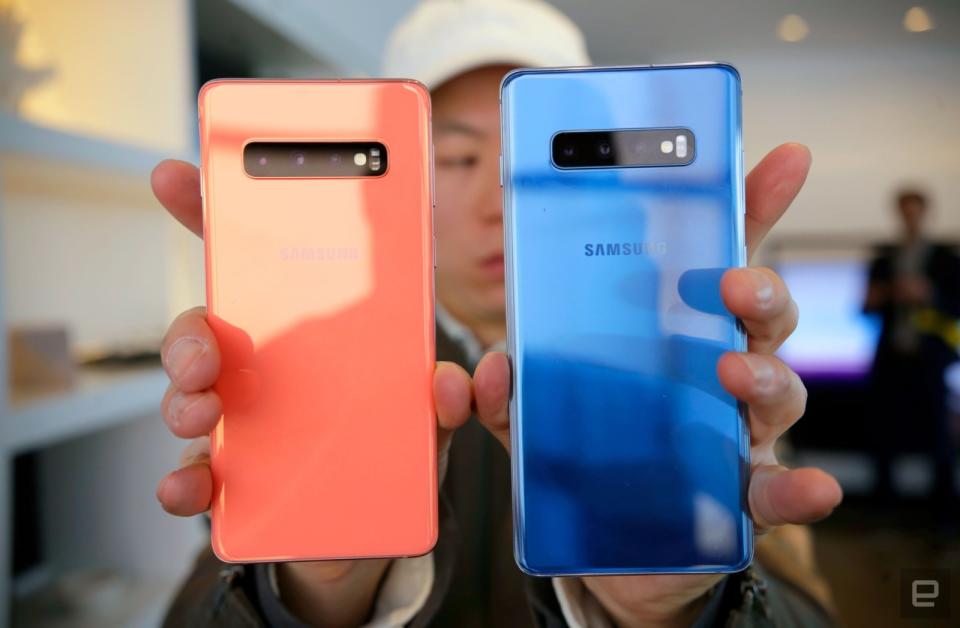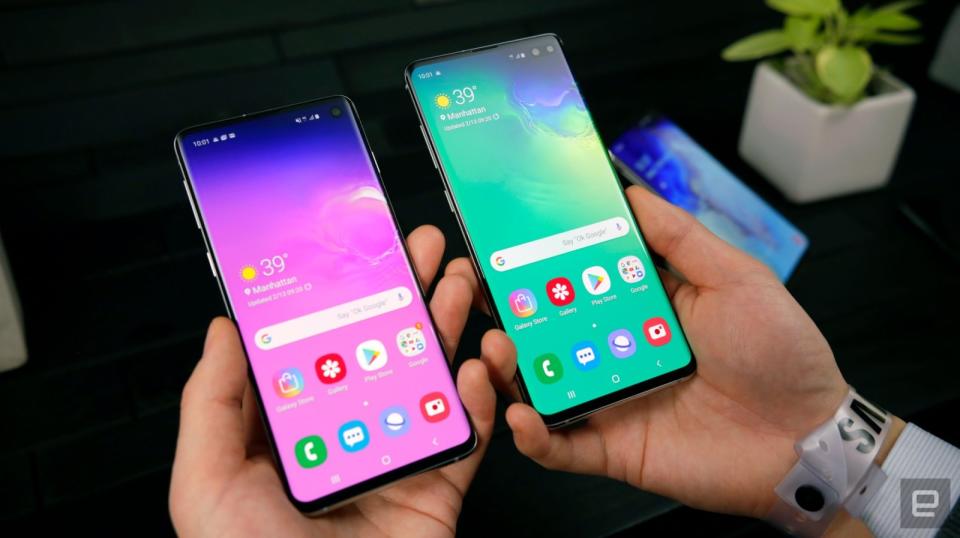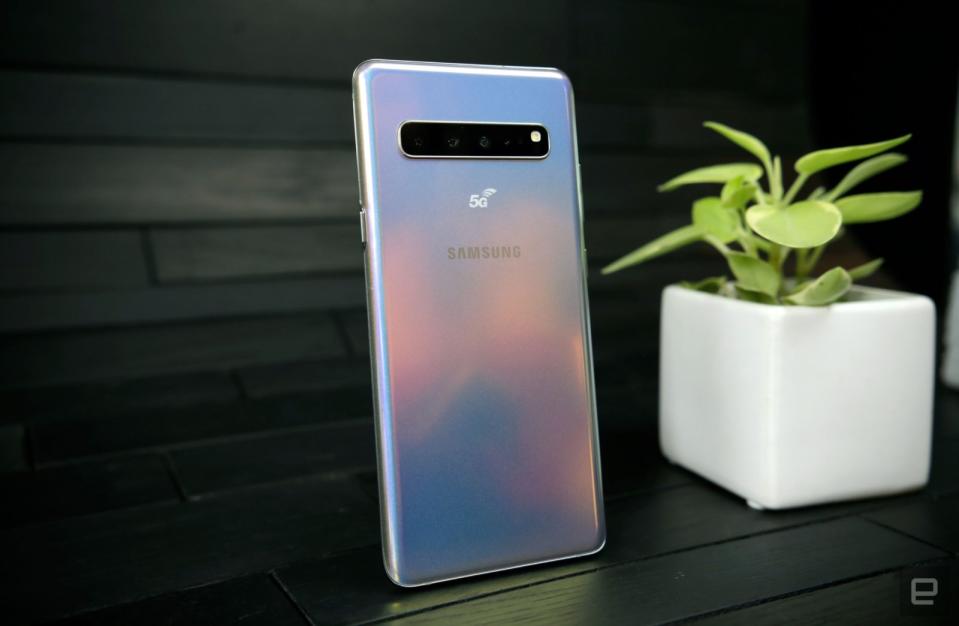Samsung Galaxy S10 and S10+ hands-on
Everything that was leaked, and not much more.
Like so many high-profile devices of the past few months, the Galaxy S10 and S10+ have been leaked to death, but there's still something exciting about the official unveiling. Maybe it's because that edge-to-edge hole-punch display looks much better in person -- not to mention what that three-camera setup is capable of, oh, and the in-screen fingerprint scanner. But I'm getting ahead of myself.
The Galaxy S10 and S10+ are two of four phones Samsung unveiled today, alongside a smaller S10e and a souped-up Galaxy S10 5G. Based on an all-too-brief hands-on, they're well-rounded, attractive flagships that, once again, iterate on a proven formula. Samsung's 2019 Galaxy series is an unsurprising mix of high-quality processors and cameras with a sumptuous screen. In fact, Samsung is so enthusiastic about the panel here that it's labeled it a "next-level Infinity display" and "all-new dynamic AMOLED." The hyperbole is real, y'all.
All about displays
The new screens take up basically the entire front of the phones. The 6.1-inch and 6.4-inch Quad HD+ panels sport tiny hole-punch cutouts for their selfie cameras. With the extra height gained from eliminating bezels completely, the screens hit a 19:9 aspect ratio instead of the 18.5:9 found on the S9. I was hoping the hole-punch design would be easier to ignore than a notch, and on the S10, it certainly is. Though I've only had a short time with the S10+, its larger cutout houses dual front cameras and will likely be harder to ignore.
Another noteworthy upgrade: the S10 and S10+ are the first smartphones to sport screens that are HDR10+ certified. This open standard is backed by dozens of companies, including Samsung, Panasonic, 20th Century Fox and Amazon, and rivals the Dolby Vision format that's used by Apple on its latest iPhones. Dolby's option is slightly more advanced, offering up to 12-bit color depth as opposed to HDR10+'s 10-bit. When it comes to displays themselves, though, I have a slight preference for Samsung's AMOLEDs, with their vibrant hues and satisfyingly deep blacks.
In-screen fingerprint reader
There's a little something extra under the panel. Instead of placing the fingerprint sensor on the rear, which leaves the cameras prone to smears, Samsung decided to embed one below the screen. The S10 and S10+ use Qualcomm's ultrasonic fingerprint scanner that reads the ridges on your skin instead of just verifying a 2D-image, like existing under-screen ones, making it tougher to spoof. This took a few more taps to set up on my demo unit than I'm used to, but after I registered my finger, the phone was quick to authenticate me, unlocking almost instantly.
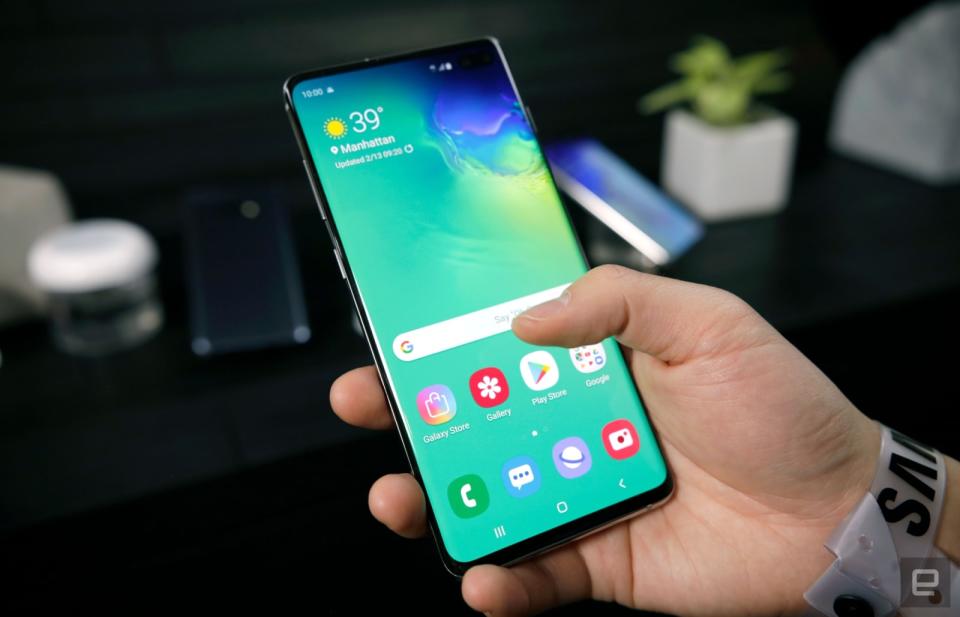
The spot where you should lay your finger is in the middle of the bottom third of the screen, and it will recognize you even if the display is off. But, you'll probably need to rely on the onscreen indicator for where to place your thumb when you first get the S10. Over time, though, it should become familiar enough that you won't even have to look -- it's pretty hard to miss.
Samsung says it uses machine-learning algorithms to improve this scanner over time, so the phone gets better and faster at recognizing your fingers. Your biometric data is stored in the Knox Trust Zone on the device, though when I say biometric data I'm referring mainly to your fingerprint -- there are no iris scanners on the S10s (face recognition is still available, for those of you who prize convenience over security).
The hands-on units we checked out didn't have screen protectors on, so I couldn't verify the rumors that the fingerprint scanner wouldn't work with them. Samsung did tell Engadget that there will be third-party screen protectors available at launch that will work with the ultrasonic scanner, though, so that at least partially debunks that rumor.

A camera threesome
Take the Note 9's dual-camera, add a third, ultra-wide option and you've got the S10's photography setup, which comes to both sizes of the handset. The new lens offers a 123-degree field of view, compared to the 77-degree "wide" and 45-degree "telephoto" ones. Respectively, those sensors are 16-megapixel, 12-megapixel and 12-megapixel. Only the "wide" camera has the dual-pixel and dual aperture features from before, while the two 12-megapixel ones have optical image stabilization.
Samsung isn't breaking any ground with this tri-camera system -- it's playing catch-up to Huawei, here, which has a similar setup on the Mate 20 Pro. The Galaxy S10 doesn't do it better than the Mate, either, as the latter has sharper sensors for clearer pictures. But the additional lens makes the S10 a more versatile shooter. With the ultra-wide option, the Galaxy S10 is able to take landscapes that squeeze in basically as much as your eyes can see. This came in handy when we were trying to squeeze six people into a group shot, and the interface is pretty easy to use -- just pinch and zoom to get closer or further away from your subject.
In addition to the updated hardware, the S10s' camera app also offers new tools. If you enable Shot Suggestion, a horizontal line stretches across the viewfinder, acting as a guide to help you keep your picture level. A dime-sized gray translucent circle also appears in the middle after you've pointed the camera at your subject for about a second. Then, the S10 will analyze the scene for better ways to compose your photo. When it's found one, a floating gray circle will appear in another part of your scene, and you'll have to line up the two orbs to get the shot. When you've correctly aligned the circles, it'll glow yellow and automatically snap the picture.

I got up close with a plant, placing it in the right third of the frame. The S10 displayed a circle just slightly left of the center of the screen, which is weird since there was nothing but a gray surface in that shot. I'll need to test this feature more before I can tell if the S10's suggested compositions were indeed better than my own, but so far I like the idea.
Like many of its rivals and the Note 9, the S10 can recognize the scene you're shooting and automatically adjust settings to optimize your photo. If you're taking a shot in extreme low light (approximately under 1 lux), the camera will suggest using a new Bright Night Shot mode, which sounds similar to the Pixel's Night Sight. Samsung said it uses different methods to improve extreme low light images, but wouldn't get specific about how. We didn't get to try this feature out at our hands-on, though, so we'll have to wait for our review unit.
Those of you who shoot lots of video with your phones should be pleased that the S10s can shoot in HDR10+. Samsung also added a Super Steady Video feature to the camera app for stabilizing footage.
Both the rear and front cameras on the S10 can shoot in 4K, which is a first for a Samsung flagship. This means you can use the new 10-megapixel front sensor to record super-sharp selfie vlogs, if you wish. Both handsets also use Samsung's dual-pixel technology up front for faster autofocus as well. On the S10+, there is an additional RGB depth-sensing camera for better portrait-mode effects, though during my hands-on, I didn't see a drastic difference between the selfies on the S10 and its larger brother.
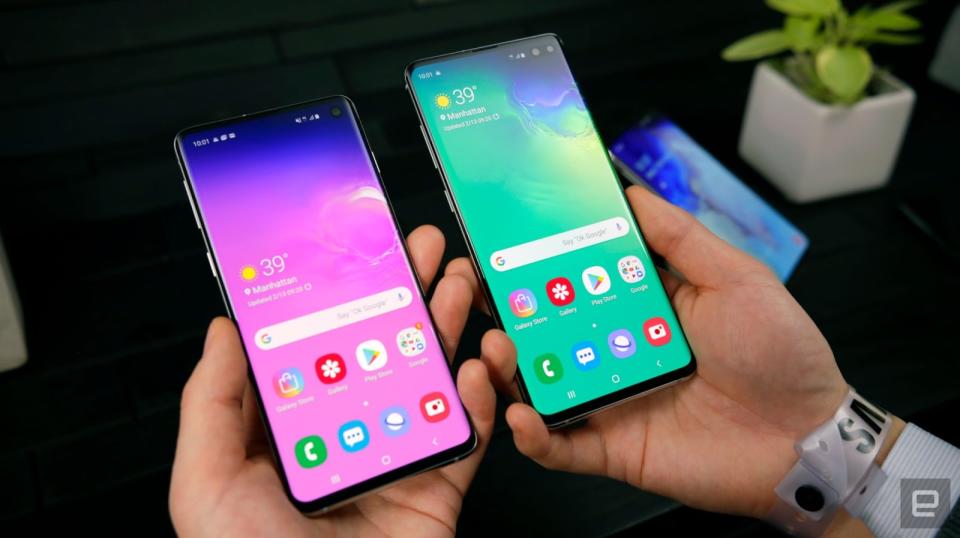
"Intelligent" performance and battery
Samsung continues to borrow features from Huawei with something it calls Intelligent performance. The new flagships pack the Snapdragon 855 chipset, and over time it will learn which apps you tend to use and kill the ones you don't need running in the background. Much like the Mate 20 Pro, the S10 is also supposed to optimize the CPU and resources like RAM by preparing apps it predicts you'll use, speeding up launch times and leading to smoother performance overall. It will also allegedly allow the S10s to squeeze over 24 hours of life out of their batteries, but we'll believe it when we see it.
Another so-called intelligent feature is the new Bixby Routines, which Samsung believes can make your life easier by using contextual clues to pre-emptively launch apps and settings you need. For example, when you get into your car, Bixby could turn on Do Not Disturb and open up Waze or Spotify. But, since these routines only kick in after you've spent some time with the phone and Bixby learns a bit about your patterns, we couldn't test it during our preview.
Everything else
There's plenty about the S10 and S10+ that we'll need to wait till a full review to check out -- like the new Wireless Powershare feature. It basically lets you turn the S10 into a wireless charging pad for Qi-compatible devices. This also works with the new Galaxy Buds, but be aware that if you use Powershare with a phone case on, it might introduce some friction there and affect the speed of your charge. It's worth noting that this is yet another feature that appears to be inspired by Huawei.
The S10s also run Samsung's new One UI -- an updated software overlay that's supposed to look cleaner and make big phones easier to use with one hand. Some of you with older Galaxy flagships like the S9 and Note 9 may already know what this looks like, and on the S10s I found the interface refreshingly clean. I'll have to explore the software more deeply to see if it's indeed easier to use in one hand, though.
As with most recent Galaxy flagships, the S10s are rated IP68 for water resistance and offer microSD support for up to 512GB of storage expansion. They'll start with 128GB of storage and 8GB of RAM, and you can go up to 512GB of storage on the smaller handset and 1TB on the plus. The larger phone also goes up to 12GB of RAM.
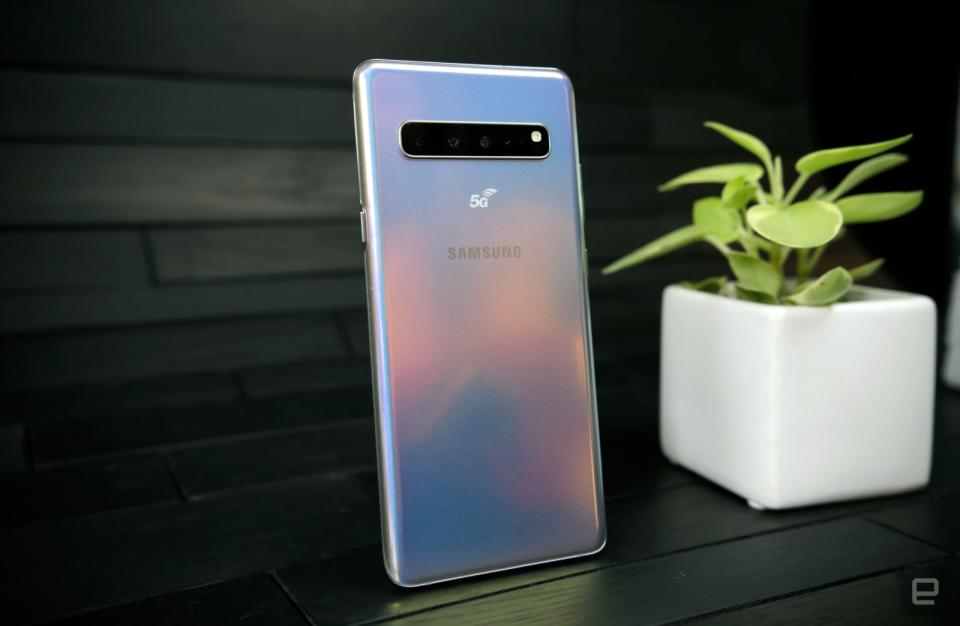
Both phones will support WiFi 6 for faster internet speeds, as well as gigabit LTE with their Snapdragon X20 modems. If you were looking for 5G (despite the networks likely not being widely available this year), you'll have to spring for the super high-end S10 that I mentioned before. It has a larger 6.7-inch screen, a bigger 4,500mAh battery and is about the same size as the Note 9. This souped up model comes with 256GB of storage, but ditches a microSD card slot, presumably to make room for the antenna arrays required for mmWaves that are a key part of 5G.
The 5G S10 has a similar camera setup as its smaller brothers but adds a 3D depth camera on the front and back, with time of flight technology for better augmented reality and portrait effects. Because we weren't allowed to even hold it ourselves during our preview, I can't really tell you how it feels or performs.
Colors, materials, price and availability
For those keeping score, we're currently up to four S10s: the S10, S10+, S10e and S10 5G. But because it's never enough to just offer one or two color options anymore, Samsung's also making different build materials available for the S10+. If you splurge and get the 512GB or the 1TB options of the S10+, you can pick from ceramic white or ceramic black flavors. The material offers better scratch resistance than aluminum and just feels classier.
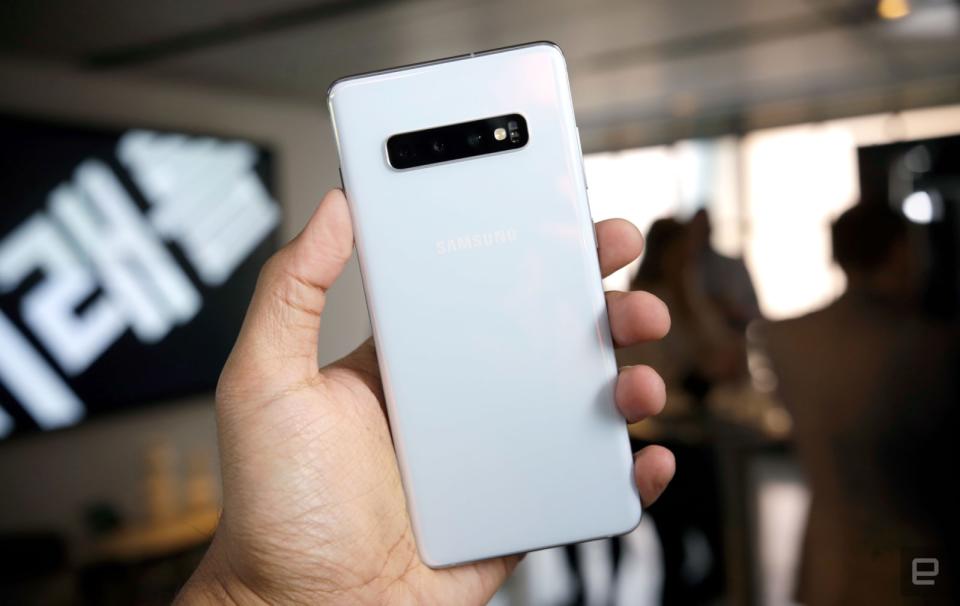
Those of us here in the US who don't need more storage and can bear the relative shame of an aluminum phone can choose between Prism black, blue, white or Flamingo Pink. The last shade is inspired by the Pantone color of the year -- "Living Coral" -- and looks more orange than pink. The Prism finishes have a slight gradient on them that catch and reflect light in an almost iridescent way that's quite pretty.
Wrap-up
It's been ten whole generations of Galaxy S, and boy, have we come far. Samsung's flagship phone series has planted the company firmly in our minds as one of the -- if not the -- best Android device maker. We've come to expect excellence from the Galaxy S series: great design, performance, cameras and displays are pretty much table stakes now. On those criteria, the new flagships seem to deliver.
But the Galaxy S10 doesn't feel like a monumental shift the way the iPhone X did. It's not a reimagination of what an entire lineup of flagships should look like. In many ways, it's Samsung playing catch-up to its Chinese rivals. If you weren't hoping for a big change with Samsung's tenth flagship, the S10 and S10+ are likely to meet those expectations. Those of us yearning for something more exciting may just have to wait for that foldable phone to arrive.
Update (on 2/22 at 11:23pm ET): This article was corrected to say it's Apple's latest iPhones that use the Dolby Vision HDR format, not Sony's Xperia XZ flagships.

